HEAVENLY ADDRESS INTRODUCTION
“At Stockton we found mean entertainment, though lodged in the mayor’s house, which was a mean thatched cottage”: attributed to Phineas Pette in 1635, master shipwright to Charles I and quoted in Sowler.1
On 1st August 1661 Thomas Rudd, soon to be curate at Stockton, observed that there were 120 dwelling houses in Stockton and none of them of brick, their construction being of lath and plaster with straw thatch.
Ralph Thoresby, an antiquarian, said in 1682 that Stockton had “a pretty town house and handsome buildings, but of no antiquity, but very prettily covered with Dutch tiles”, as quoted by Sowler.1
By the time of the opening of the new church of St. Thomas in1712 Rudd (Vicar) was able to describe the “flourishing condition this place is now in; how much improved of late years; what fair, fine and stately houses most of us have lately built”.2
Brewster confirmed that “the dwelling-houses are all of brick, covered with pantiles or slate” 3 and that Paradise Row was “extremely elegant and pleasant” 4
A newspaper advertisement 5 from 1808 describes one property in Paradise Row as ‘genteel, modern and with every convenience’:
a Dining Room, Servants’ Hall, Kitchen, Back Kitchen and pantry ;
an elegant Drawing Room, 4 Lodging Rooms, 2 Servants’ Rooms ;
Coal cellar, wine & beer cellars; yard, pump, cistern, stable, saddle house, chaise house;
Iron palisades, balcony;
With a view of the new Square, the River Tees and the Cleveland Hills.
So where is or was Paradise Row ?
For this article, Paradise Row means the current properties (70 – 82) on the north side of Church Road as shown on diagram 1. These properties clearly appear on successive maps between about 1826 and 1911. It should be noted that between 1851 and about 1950 the properties currently 88 to 106 in Church Road were also described as Paradise Row, but these are not included here.
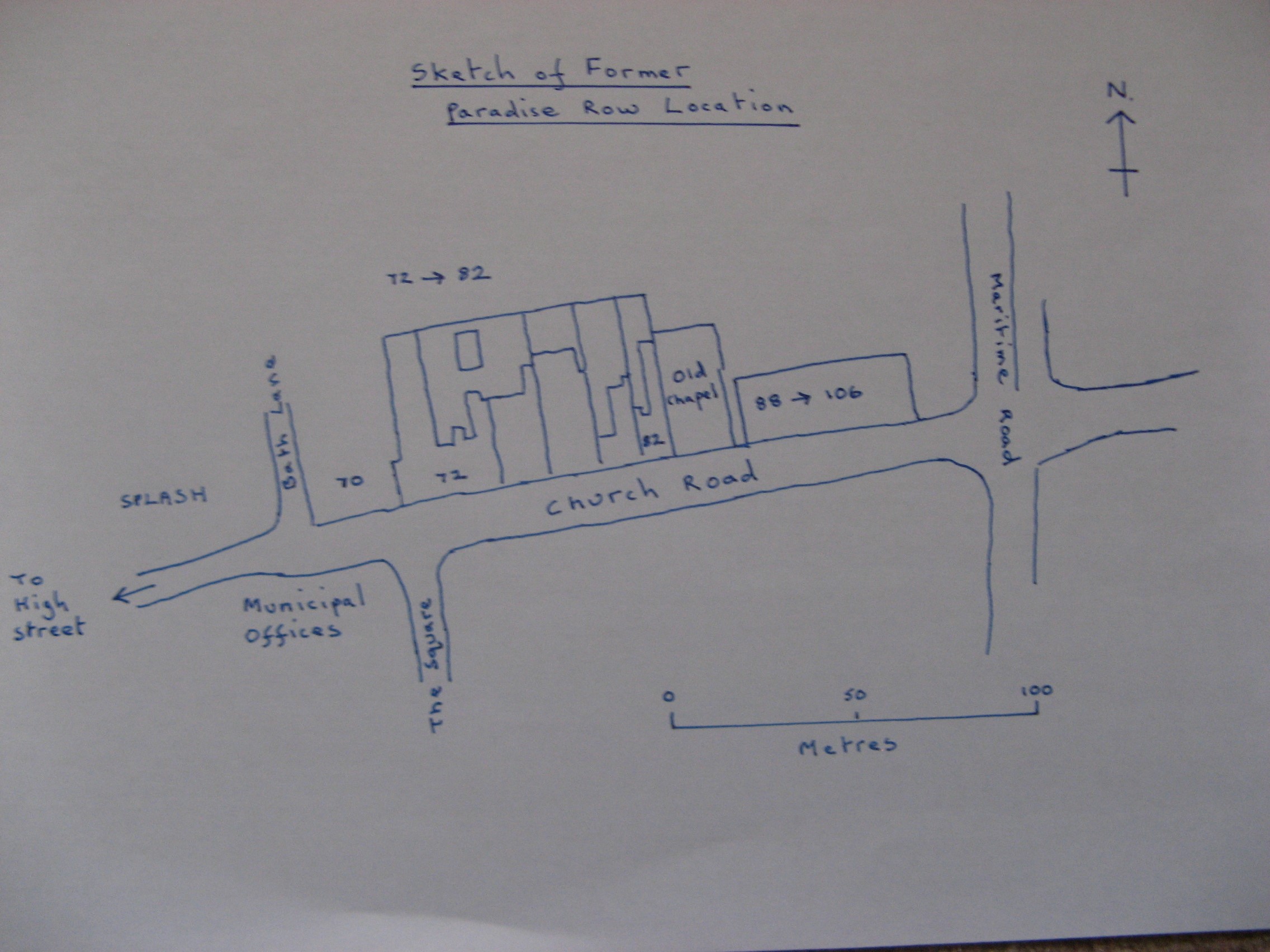

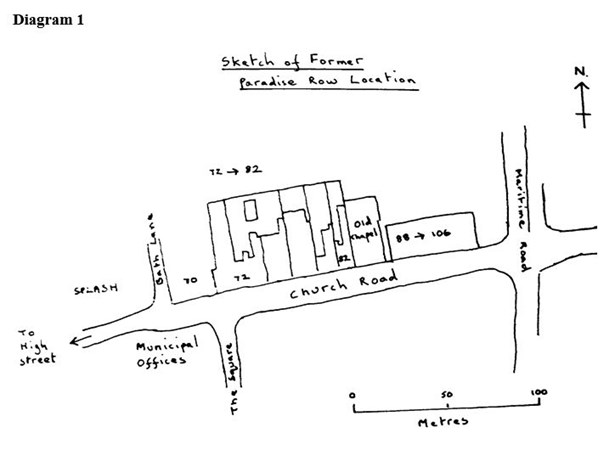
When were the houses built ?
This is rather difficult to answer fully. In 1722 a map surveyed by Thomas Pattison 6 shows Douthwaite’s buildings on the site of Paradise Row (as shown on diagram 1). According to Thomas Richmond, “Douthwaite’s buildings (afterwards the ropery) are now named Paradise Row” but this is inconclusive especially as Bayley (see ref.7) suggests that Paradise Row was on the site of an ancient ropery. The architecture of the properties in Paradise Row clearly suggests Georgian origin, but this alone will not lead to accurate dating. Georgian architecture broadly relates to building styles in the reigns of George I to George IV i.e. from 1714 to 1830. The descriptions of these properties as listed buildings, suggest the Georgian period. Deeds, of course, could give much more reliable information. Also it is not possible to say with certainty that these properties all date from the same time, indeed an engraving 6 by John Sutton dated 1792 appears to suggest otherwise. Given the likely age of these properties it is important to remember that they will have undergone some if not considerable alteration/renovation especially inside, so the emphasis is on Georgian style. This particularly applies to windows, doors and roof coverings. Another aspect worthy of mention is the brickwork. The facades are still mainly of the original brick. Except for 9 Paradise Row (82 Church Road) the brick bond is Flemish. This same Flemish bond appears to have been used in the parish church, of St. Thomas (completed 1712).
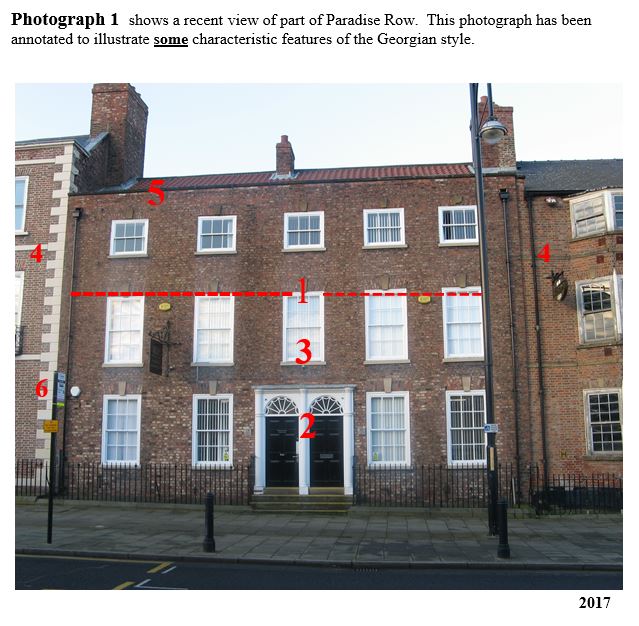
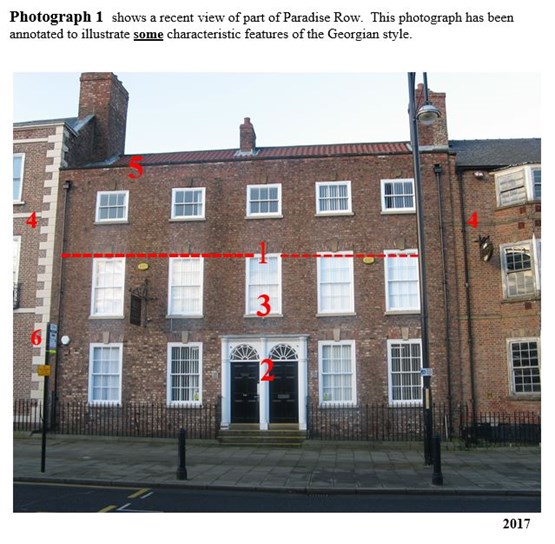
Key to photograph 2
- Symmetry e.g. balanced positioning and size of windows, doors etc
- Pedimented and panelled doors often with classical pillars/pilasters and fanlights
- Sash windows
- String courses
- Parapets
- Quoin stones
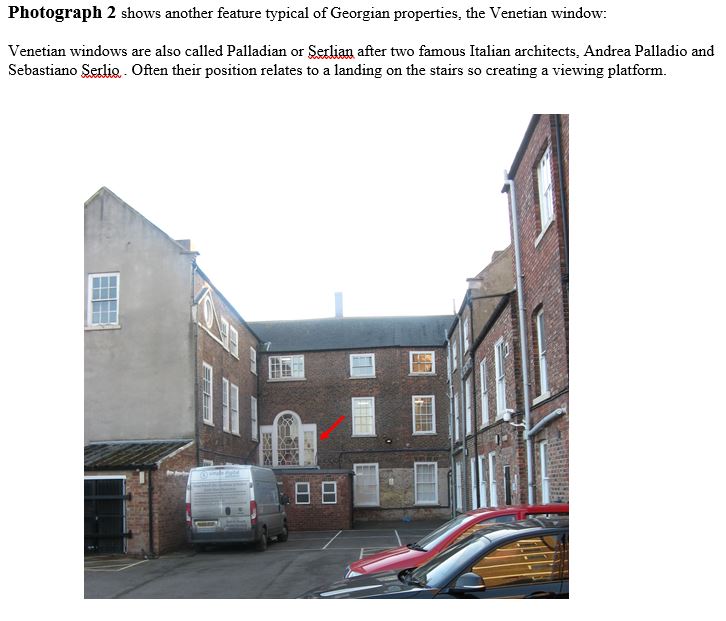

Why were the houses called “Paradise Row”?
This is very difficult if not impossible to answer, but that does not prevent speculation. Paradise is a term for a place of timeless harmony and a common linked idea is the Garden of Eden. The Greek word, paradeisos means a garden and stems from a Persian word meaning a walled area, especially a garden. Other possibilities are a favourable area of land especially one with good pasture or an area used as a pleasure garden/ground…e.g. near a monastery, cathedral etc....so the idea of something aesthetically appealing may be the simple answer. At the time of construction, Paradise Row would have had very pleasant views across the Tees towards the Cleveland Hills.
Paradise is also used as a surname and this too could be an explanation. This surname, as it is found in this country, may have arrived with the Huguenots or even earlier. The word “Paradis” appears in Old French meaning a pleasant place.
Who built these houses?
This is an even more problematic issue. So far researches have shown few indications in terms of builders, designers etc. Remember that architects, as currently understood i.e. properly trained and qualified, were rare before 1750……note that the RIBA only dates from 1834. In the 17th and 18th centuries much building involved the well-off, using masons and builders. Landed gentry who had been on the ‘Grand Tour’ may have designed their own buildings, though these designs were often adapted copies or taken from published plans. Visual evidence, current and past, suggests that the properties may not be the work of one person. Further research may provide more information. One source suggests that 1 Paradise Row was the home of John Scurfield 7 in 1760 and had been erected by Captain Reynolds. Heavisides writing in 1865 confirms that 1 Paradise Row came to George Hutchinson from his uncle John Scurfield. So far, more details about this or about Captain Reynolds have proved elusive.
Who has lived in these houses? Actually, quite a lot of information is available about those who lived in these houses, some as tenants, some as owners. Three periods can be identified:
- Before 1841 : some information can be gained from sources such as Trade Directories, Newspapers, Genealogical Records/Notes and Wills.
- 1841 to 1911 inclusive: census records reveal a lot of details: names, ages, birthplaces, employment and social standing and analysis of these shows that :
Some of the residents were relatively wealthy and well- known families e.g. Joshua Byers 1871 - 1891.
Some of the heads of the households had professional jobs reflecting a good education e.g. solicitors such as William Newby
Some of the heads of households had their own business e.g. Robert Craggs, Timber Merchant 1851 & 1861.
Some heads of household were classed as of independent means e.g. Jane Wilson 1891 & 1901.
Most of the householders had servants e.g. Anthony Reed 1841 & 1851.
Some of the families employed staff to look after their children e.g. Charles Hill 1871 & 1881.
- After 1911: not covered here, but this could be a rich source of material for other researchers.
Readers are invited to follow the story of Paradise Row by looking at the rest of the series which looks at each of the 9 houses in turn.
REFERENCES
General :
Sowler, Tom “A History of the Town and Borough of Stockton-on-Tees, 1972
Richmond, Thomas “Local Records of Stockton-upon-Tees and Neighbourhood”, 1868
Brewster, John “The Parochial History and Antiquities of Stockton upon Tees, 1796” / “The Parochial history and antiquities of Stockton upon Tees, 1829”
Heavisides, Henry “The Annals of Stockton-on-Tees with biographical notes”, 1865
Various Trade Directories
More specific :
- See A page 111
- See C page 259 1829 edition
- See C page 222 1829 edition
- See C page 87 1796 edition
- Online at www.findmypast /newspapers
- Stockton Library Maps etc.
- Online “GENEALOGICAL ADDITIONS TO THE HISTORY OF STOCKTON UPON TEES” W.D.Bayley 1848
- See www.ancestry.co.uk and other sources e.g. family search
